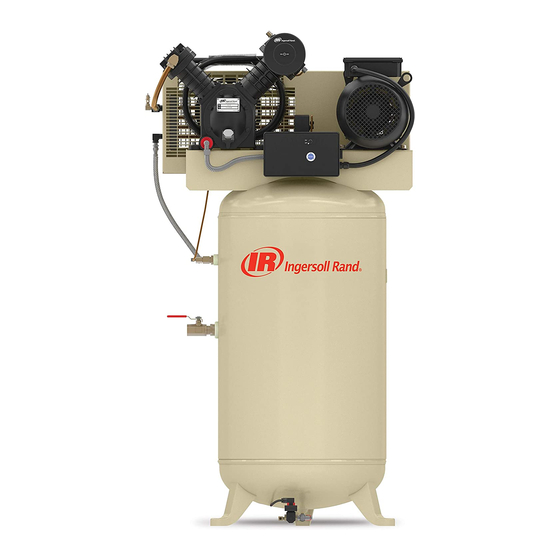
Ingersoll Rand 2340 Instrucciones De Instalación, Operación Y Mantenimiento
Ocultar thumbs
Ver también para 2340:
- Manual del usuario (76 páginas) ,
- Instrucciones de instalación, operación y mantenimiento (57 páginas) ,
- Manual del usuario (57 páginas)
Tabla de contenido
Publicidad
Idiomas disponibles
Idiomas disponibles
Enlaces rápidos
Ingers011Rand
Owner's
Manual
Installation,
Operation
and Maintenance
Instructions
for Standard
Two-Stage
Lubricated
Air Compressors
(Electric Motor and Gasoline
Engine Models Up to 30 Horsepower)
IMPORTANT
INFORMATION!
READ AND FOLLOW THESE INSTRUCTIONS.
RETAIN FOR REFERENCE.
_.'f.'!=1 _/b'd
DEFINITIONS
A__
WILL cause DEATH, SEVERE INJURY or substantial
property damage.
/k WARNING
CAN cause DEATH, SEVERE INJURY or substantial
property damage.
/_ CAUTION
WILL or CAN cause MINOR INJURY or property
damage.
GENERAL
SAFETY
PRECAUTIONS
A__'_
INTAKE AIR. Can contain carbon monoxide or other
contaminants.
Will cause serious injury or death.
Ingersoll-Rand
air compressors
are not designed,
intended or approved for breathing air. Compressed
air should not be used for breathing air applications
unless treated in accordance with all applicable
codes and regulations.
/_ WARNING
HAZARDOUS
VOLTAGE. Can cause serious injury
or death. Disconnect power and bleed pressure
from the tank before servicing. Lockout/Tagout
machine. Compressor
must be connected to
properly grounded circuit. See grounding
instructions
in manual. Do not operate compressor
in wet conditions.
Store indoors.
/k CAUTION
MOVING PARTS. Can cause serious injury. Do not
operate with guards removed. Machine may start
automatically.
Disconnect power before servicing.
LockoutJTagout
machine.
HOT SURFACES.
Can cause serious injury. Do not
touch. Allow to cool before servicing. Do not touch
hot compressor
or tubing.
HIGH PRESSURE
AIR. Bypassing, modifying
or
removing safety/relief valves can cause serious
injury or death. Do not bypass, modify or remove
safety/relief valves. Do not direct air stream at body.
Rusted tanks can cause explosion and severe injury
or death. Drain tank daily or after each use. Drain
valve located at bottom of tank.
RISK OF BURSTING. Use only suitable air handling
parts acceptable for pressure of not less than the
maximum allowable working pressure of the
machine.
[€-] : 1_1:1 dL, ImlII_I_o - v];_.111Ko] _I
INTRODUCTION
This manual provides
safe and reliable
instructions
for the
installation,
operation
and maintenance
of your Ingersoll-Rand
air
compressor.
Carefully
read this manual
before attempting
to
operate or perform any maintenance.
If you are uncertain
about any
of the instructions or procedures
provided
in this manual, contact
Ingersoll-Rand.
We recommend
you retain this manual,
and all
publications
provided
with your air compressor,
in a location
which
is accessible
to all personnel
who operate
and service
your
compressed
air equipment.
APPLICATION
IngersolI-Rand's
standard
two-stage lubricated
air compressors
are
single-acting,
air-cooled
machines.
Typical compressors
are
furnished
as compact,
self-contained,
air receiver tank mounted
units that are automatically
regulated
and driven by an electric
motor or gasoline
engine.
An air-cooled
aftercooler,
low oil level
shutdown
switch and automatic
drain valve are among the optional
accessories
that can be furnished.
Bare compressor
pumps and
baseplate-mounted
units are also available.
These compressors
may be used for a variety
of compressed
air
application
up to 250 PSIG (17.5 kg/cm2). Application
of these
compressors
as either a primary or supplementary
source of air is
virtually
unlimited
in industrial
plants, service
stations and auto
repair shops.
Supplementary
service
includes such uses as
furnishing
air at pressure
not carried
in regular shop lines, air at
isolated
locations,
and standby
service
for air when larger
compressors
are shut down.
TWO-STAGE
OPERATION
Two-stage
compressors
consist of one or two first-stage
cylinders
with the same bore size and one second-stage
cylinder with a
smaller
bore size.
Typical Two-Stage,
Two
Cylinder Unit
Typical Two-Stage,
Three
Cylinder Unit
The basic principle
of operation
is as follows:
On the suction
stroke
of the first-stage
piston(s),
air at atmospheric
pressure
enters the
cylinders
through the inlet filter(s)
and then the inlet valves located
in the head. On the compression
stroke of the first-stage
piston(s),
the air is compressed
to an intermediate
pressure
and discharged
through the discharge
valves(s)
into common
manifold(s).
From the
manifold(s)
the air passes through the intercooler
tubes, where the
heat of first-stage
compression
is removed.
On the suction stroke of
the second-stage
piston this cooled air enters the second-stage
cylinder
through the inlet valve. The compression
stroke of the
second-stage
piston compresses
the air to the final discharge
pressure
and forces it out through the discharge
valve into the
receiver
tank or system.
If cooling of the discharge
air is required,
© Ingersoll-Rand
Company
Printed
in U.S.A.
Form SCD-838A
August 2001
Publicidad
Tabla de contenido













